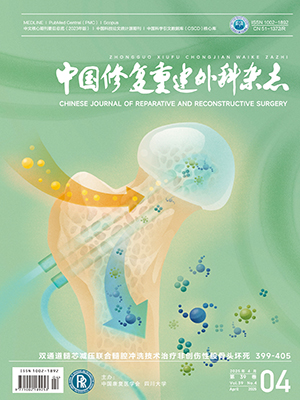| 1. |
林振恩, 郑竑, 陈学生, 等. 改良闭合复位技术治疗股骨颈骨折疗效分析. 中国骨伤, 2018, 31(2): 115-119.
|
| 2. |
张学全, 樊仕才, 黎惠金, 等. 带旋髂深血管髂骨瓣和股方肌骨瓣移植治疗青壮年GardenⅢ-Ⅳ型股骨颈骨折的比较. 中国骨伤, 2015, 28(9): 802-807.
|
| 3. |
桂景雄, 王小平, 邓志成, 等. 闭合复位经皮微创加压空心螺钉内固定治疗股骨颈骨折的临床观察. 创伤外科杂志, 2015, 15(4): 367-368.
|
| 4. |
曾剑文, 张华亮, 谢建军, 等. 青壮年股骨颈骨折股骨近端空心钉锁定钢板固定效果评价. 武警医学, 2016, 27(1): 20-22.
|
| 5. |
Slobogean GP, Sprague SA, Scott T, et al. Management of young femoral neck fractures: is there a consensus? Injury, 2015, 46(3): 435-440.
|
| 6. |
Pauyo T, Drager J, Albers A, et al. Management of femoral neck fractures in the young patient: A critical analysis review. World J Orthop, 2014, 5(3): 204-217.
|
| 7. |
彭方成, 王贤月, 王鹏, 等. 股骨近端空心钉锁定板内固定治疗成人股骨颈骨折. 中国骨与关节损伤杂志, 2015, 30(12): 1305-1306.
|
| 8. |
Yang JJ, Lin LC, Chao KH, et al. Risk factors for nonunion in patients with intracapsular femoral neck fractures treated with three cannulated screws placed in either a triangle or an inverted triangle configuration. J Bone Joint Surg (Am), 2013, 95(1): 61-69.
|
| 9. |
Kain MS, Marcantonio AJ, Iorio R. Revision surgery occurs frequently after percutaneous fixation of stable femoral neck fractures in elderly patients. Clin Orthop Relat Res, 2014, 472(12): 4010-4014.
|
| 10. |
Han SK, Song HS, Kim R, et al. Clinical results of treatment of garden type 1 and 2 femoral neck fractures in patients over 70-year old. Eur J Trauma Emerg Surg, 2016, 42(2): 191-196.
|
| 11. |
Zielinski SM, Keijsers NL, Praet SF, et al. Femoral neck shortening after internal fixation of a femoral neck fracture. Orthopedics, 2013, 36(7): e849-858.
|
| 12. |
Zlowodzki M, Ayeni O, Petrisor BA, et al. Femoral neck shortening after fracture fixation with multiple cancellous screws: incidence and effect on function. J Trauma, 2008, 64(1): 163-169.
|
| 13. |
Stoffel K, Zderic I, Gras F, et al. Biomechanical evaluation of the femoral neck system in unstable Pauwels Ⅲ femoral neck fractures: A comparison with the dynamic hip screw and cannulated screws. J Orthop Trauma, 2017, 31(3): 131-137.
|
| 14. |
Schopper C, Zderic I, Menze J, et al. Higher stability and more predictive fixation with the femoral neck system versus Hansson pins in femoral neck fractures Pauwels Ⅱ. J Orthop Translat, 2020, 24: 88-95.
|
| 15. |
Harris WH. Traumatic arthritis of the hip after dislocation and acetabular fractures: treatment by mold arthroplasty. An end-result study using a new method of result evaluation. J Bone Joint Surg (Am), 1969, 51(4): 737-755.
|
| 16. |
Dhar SA, Gani NU, Butt MF, et al. Delayed union of an operated fracture of the femoral neck. J Orthop Traumatol, 2008, 9(2): 97-99.
|
| 17. |
Slobogean GP, Stockton DJ, Zeng B, et al. Femoral neck fractures in adults treated with internal fixation: A prospective multicenter Chinese cohort. J Am Acad Orthop Surg, 2017, 25(4): 297-303.
|
| 18. |
Stacey SC, Renninger CH, Hak D, et al. Tips and tricks for ORIF of displaced femoral neck fractures in the young adult patient. Eur J Orthop Surg Traumatol, 2016, 26(4): 355-363.
|
| 19. |
Kim JW, Byun SE, Chang JS. The clinical outcomes of early internal fixation for undisplaced femoral neck fractures and early full weight-bearing in elderly patients. Arch Orthop Trauma Surg, 2014, 134(7): 941-946.
|
| 20. |
Jain R, Koo M, Kreder HJ, et al. Comparison of early and delayed fixation of subcapital hip fractures in patients sixty years of age or less. J Bone Joint Surg (Am), 2002, 84(9): 1605-1612.
|
| 21. |
Simunovic N, Devereaux PJ, Sprague S, et al. Effect of early surgery after hip fracture on mortality and complications: systematic review and meta-analysis. CMAJ, 2010, 182(15): 1609-1616.
|
| 22. |
赵勇, 秦伟凯. 重视股骨颈骨折的评估与内固定治疗的若干问题. 中国骨伤, 2021, 34(3): 195-199.
|
| 23. |
Panteli M, Rodham P, Giannoudis PV. Biomechanical rationale for implant choices in femoral neck fracture fixation in the non-elderly. Injury, 2015, 46(3): 445-452.
|
| 24. |
Liporace F, Gaines R, Collinge C, et al. Results of internal fixation of Pauwels type-3 vertical femoral neck fractures. J Bone Joint Surg (Am), 2008, 90(8): 1654-1659.
|
| 25. |
王青, 姜达君, 贾伟涛. Pauwels三型股骨颈骨折不同内固定方式的meta分析. 上海交通大学学报 (医学版), 2018, 38(9): 1045-1052.
|
| 26. |
Kunapuli SC, Schramski MJ, Lee AS, et al. Biomechanical analysis of augmented plate fixation for the treatment of vertical shear femoral neck fractures. J Orthop Trauma, 2015, 29(3): 144-150.
|
| 27. |
Mei J, Liu S, Jia G, et al. Finite element analysis of the effect of cannulated screw placement and drilling frequency on femoral neck fracture fixation. Injury, 2014, 45(12): 2045-2050.
|
| 28. |
Kloen P, Rubel IF, Lyden JP, et al. Subtrochanteric fracture after cannulated screw fixation of femoral neck fractures: a report of four cases. J Orthop Trauma, 2003, 17(3): 225-229.
|
| 29. |
Li J, Wang M, Zhou J, et al. Optimum configuration of cannulated compression screws for the fixation of unstable femoral neck fractures: Finite element analysis evaluation. BioMed research international, 2018, 9: 1271762. doi: 10.1155/2018/1271762.
|
| 30. |
范智荣, 苏海涛, 周霖, 等. 新型股骨颈内固定系统治疗不稳定性股骨颈骨折的有限元分析. 中国组织工程研究, 2021, 25(15): 2321-2328.
|
| 31. |
刘智. 应重视股骨颈骨折的内固定手术治疗. 中国骨伤, 2021, 34(3): 200-202.
|
| 32. |
杨亚军, 马涛, 张小钰, 等. 股骨颈动力交叉钉系统治疗股骨颈骨折近期疗效. 中国修复重建外科杂志, 2021, 35(5): 539-543.
|
| 33. |
许新忠, 常菁, 余水生, 等. 股骨颈系统固定治疗股骨颈骨折的近期疗效分析. 中华创伤骨科杂志, 2020, 22(7): 624-627.
|




